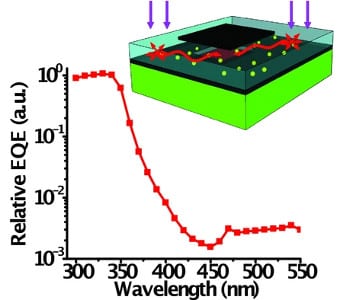 Visible-blind ultraviolet (UV) detectors, which are only sensitive to UV light, but insensitive to visible and infrared light, have several potential applications including flame detection, chemical sensing, communication, etc. In Advanced Optical Materials Professor John A. Rogers (University of Illinois) and collaborators present a self-powered, visible-blind UV detection design using silicon based photodetectors combined with UV sensitive luminescent materials.
Visible-blind ultraviolet (UV) detectors, which are only sensitive to UV light, but insensitive to visible and infrared light, have several potential applications including flame detection, chemical sensing, communication, etc. In Advanced Optical Materials Professor John A. Rogers (University of Illinois) and collaborators present a self-powered, visible-blind UV detection design using silicon based photodetectors combined with UV sensitive luminescent materials.
Specifically, a UV sensitive polymer film absorbs and converts UV light (from 300 nm to 360 nm) into visible light, which is collected by the top-mounted Si detectors through a waveguide structure. The obtained ratio of photoresponses for UV light (300–360 nm) and visible light (>400 nm) is ≈102–103. Such devices are demonstrated to detect UV emission from invisible methanol flames. Furthermore, a 16 × 16 detector array was used to demonstrate a prototype imaging system. The concept appears readily adaptable to conventional large-area Si-based image sensors, thereby providing a low-cost route to high-resolution visible-blind UV imaging.

















